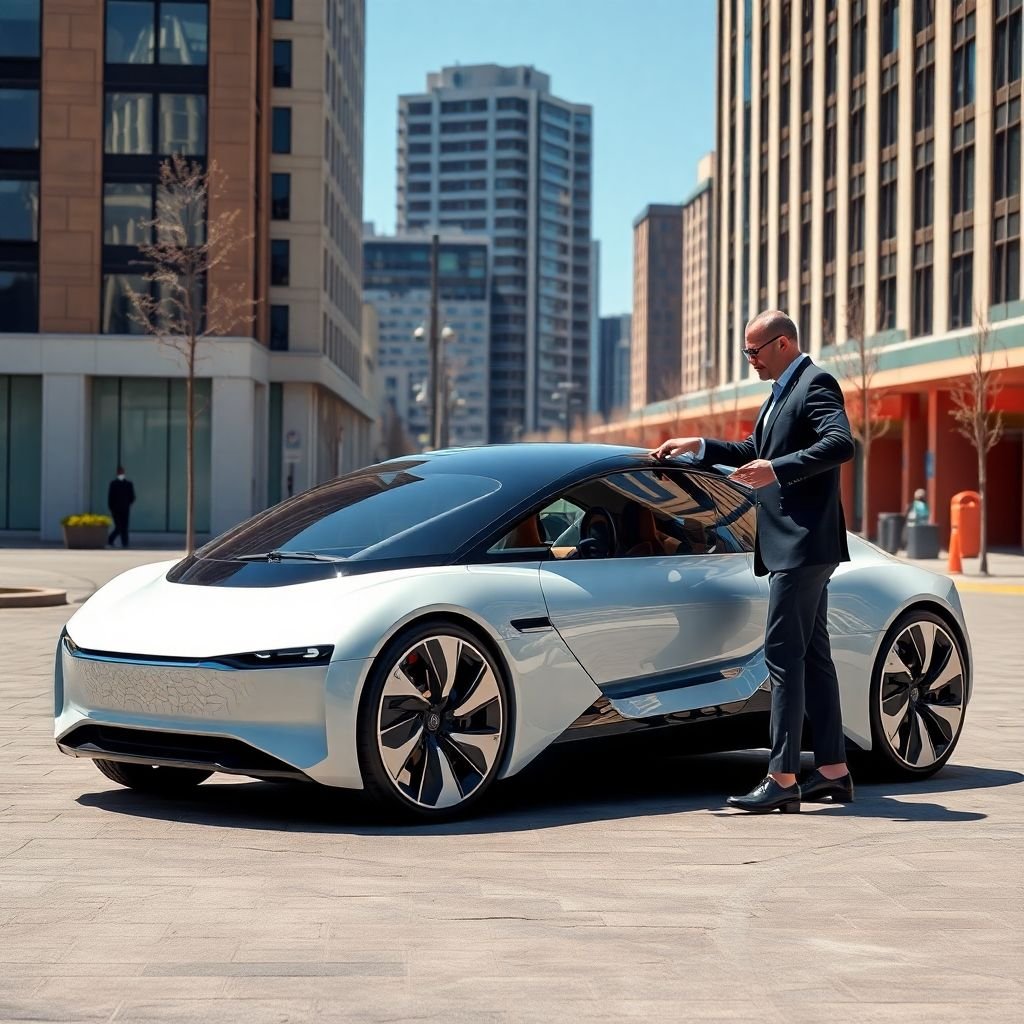A new player is entering the electric vehicle arena, and it’s not just any player—it’s a billionaire with big plans. This venture aims to create a more affordable electric car model that could give Tesla a run for its money. As the electric vehicle market continues to grow, this ambitious project could shake things up and change the landscape of electric cars as we know it. Let’s take a closer look at what this all means for the future of electric vehicles and Tesla’s position in the market.
Key Takeaways
- A billionaire is spearheading a project to develop a cheaper electric car to rival Tesla.
- This new model aims to disrupt the current electric vehicle market dominated by Tesla.
- The venture is backed by significant investment, indicating strong confidence in its potential.
- Innovative features and sustainability initiatives are central to the new car’s design.
- The success of this project could reshape consumer choices in the electric vehicle sector.
Billionaire’s Ambitious Vision
Overview of the Project
So, there’s this billionaire, right? And they’ve decided that Elon Musk needs some competition. The plan? To create a cheaper electric car. It sounds simple, but the scale of the project is pretty huge. We’re talking about a full-on assault on the electric vehicle market, aiming to undercut Tesla’s prices and appeal to a broader range of consumers. It’s not just about making a car; it’s about changing the game. The project is shrouded in secrecy, but the rumours are flying thick and fast.
Key Players Involved
Okay, so the billionaire’s name is still under wraps, which is adding to the mystery. But we do know a few things. Apparently, they’ve poached some top talent from other car companies, including a few ex-Tesla engineers. There’s also talk of a partnership with a major battery manufacturer, which would be a smart move. The team seems to be a mix of seasoned automotive professionals and fresh, innovative minds. It’s a recipe that could either be a disaster or a stroke of genius. It’s also worth noting that some of the key players have a background in business development, which suggests they’re serious about making this a profitable venture.
Potential Impact on the Market
If this project actually gets off the ground, it could really shake things up. Tesla has had a pretty good run, but a serious competitor with a cheaper model could force them to rethink their strategy. Consumers would benefit from more choice and lower prices, and it could accelerate the adoption of electric vehicles in general. Of course, there’s also the risk that the project will fail, leaving Tesla unchallenged. But even the threat of competition could push Tesla to innovate faster and improve their products. It’s a high-stakes game, and the potential rewards are enormous.
The success of this project hinges on a few key factors: securing funding, developing innovative technology, and building a strong brand. If they can pull all of that off, they could be a serious contender in the electric vehicle market.
Here’s a quick look at the potential market impact:
- Increased competition in the EV market
- Potential price drops for electric vehicles
- Faster adoption of electric vehicle technology
Challenging Tesla’s Dominance
Current Market Landscape
Right now, Tesla’s pretty much the king of the electric car market, but things are starting to heat up. You’ve got established car companies like Ford and VW getting serious about EVs, and then there’s a whole bunch of new startups trying to muscle in. It’s becoming a crowded space, and Tesla can’t just assume it’ll stay on top forever. The sheer volume of new entrants is staggering, and they’re all aiming for a piece of the pie. It’s not just about making electric cars anymore; it’s about making them better, cheaper, and more appealing to a wider range of people. The electric car market is definitely one to watch.
Tesla’s Response to Competition
Tesla isn’t just sitting back and watching, of course. They’re constantly tweaking their models, improving battery tech, and expanding their charging network. The company is also trying to cut costs to stay competitive on price. But it’s a tough balancing act. They need to keep innovating to stay ahead, but they also need to make sure they’re not pricing themselves out of the market. It will be interesting to see how they respond to this new billionaire’s project. They might need to rethink their strategy if this new car really takes off. Here’s a quick look at how Tesla’s sales have changed recently:
| Quarter | Sales (Units) |
|---|---|
| Q1 2024 | 422,000 |
| Q2 2024 | 466,000 |
| Q3 2024 | 435,000 |
| Q4 2024 | 484,000 |
Consumer Sentiment Towards New Entrants
People are generally pretty excited about the idea of more electric car options. No one wants to be stuck with just one choice, and a lot of folks are keen to see what new features and designs other companies can bring to the table. There’s definitely an appetite for something different, especially if it’s more affordable than a Tesla. But there’s also a lot of trust in the Tesla brand, so any new entrant has to prove they can deliver on quality and reliability. Here are some things consumers are looking for:
- Lower prices
- Longer range
- Faster charging
Ultimately, it’s all about giving consumers more choice and pushing the boundaries of what’s possible with electric vehicles. The more competition there is, the better it is for everyone.
Innovative Technology and Design

Features of the New Electric Car
Okay, so what’s this new electric car actually like? Well, from what I’ve gathered, the focus is on a modular battery system. This means you could potentially upgrade your battery pack later on, or even swap it out for a fully charged one at designated stations – pretty neat, eh? They’re also talking about a new type of motor that’s supposed to be more efficient and use fewer rare earth materials. The design is rumoured to be quite minimalist, with a big emphasis on interior space and a massive touchscreen dominating the dashboard. I’m not sure how I feel about that last bit, I like buttons!
Sustainability Initiatives
It’s not just about electric cars anymore; it’s about how sustainably they’re made. This new company seems to be taking that seriously. Here’s what they’re planning:
- Using recycled materials wherever possible, including plastics and aluminium.
- Sourcing battery materials from ethical and sustainable sources.
- Implementing a closed-loop manufacturing process to minimise waste.
- Partnering with renewable energy providers to power their factory.
The company is aiming for carbon neutrality in its production process, which is a bold claim. They’re also looking at ways to recycle old batteries, which is a huge issue for the electric vehicle industry as a whole.
Comparative Analysis with Tesla Models
Let’s be real, everyone’s going to compare this to Tesla. The key difference seems to be the price point. While Tesla is still seen as a premium brand, this new car is aiming for the mass market. Here’s a quick comparison:
| Feature | New Electric Car | Tesla Model 3 | Tesla Model Y |
|---|---|---|---|
| Starting Price | £30,000 (est.) | £40,000 | £45,000 |
| Range (WLTP) | 300 miles (est.) | 330 miles | 315 miles |
| 0-60 mph | 6.0 seconds | 5.8 seconds | 5.0 seconds |
| Battery Capacity | 60 kWh (est.) | 60 kWh | 75 kWh |
Of course, these are just estimates at this point, but it gives you an idea. The new car might not be as fast or have as much range as a Tesla, but it could be a lot more affordable. It will be interesting to see how the top 20 electric cars compare once this new model is released.
Funding and Investment Strategies

Sources of Capital
So, where’s the money coming from for this Tesla challenger? Well, that’s the million-dollar question, isn’t it? Or, more accurately, the billion-dollar question. It’s not just about having a great idea; you need serious cash to bring it to life, especially in the automotive industry. We’re likely looking at a mix of sources. Obvious contenders include venture capital firms, always on the hunt for the next big thing. Then there’s the possibility of private equity, where firms invest in established companies to restructure and improve them. And, of course, there’s the potential for an IPO (Initial Public Offering) down the line, but that’s usually further along the road. Don’t forget government incentives either; many countries offer grants and tax breaks to companies developing green technologies, and electric vehicles definitely fall into that category. It’s a complex puzzle, and piecing it together will be key to understanding the project’s viability. It’s worth noting that Slate Auto is reportedly backed by Jeff Bezos.
Investment Trends in Electric Vehicles
Investing in electric vehicles is hot right now. Everyone wants a piece of the action, from established automakers to tech giants and even individual investors. You see a lot of money flowing into battery technology, charging infrastructure, and, of course, the development of new EV models. What’s interesting is the shift towards sustainability and ethical sourcing of materials. Investors are increasingly looking at the environmental impact of their investments, which puts pressure on companies to adopt responsible practises. There’s also a growing interest in alternative battery chemistries, like solid-state batteries, which promise greater energy density and safety. The competition for funding is fierce, but companies with innovative technology and a strong business plan are well-positioned to attract investment. Here’s a quick look at recent investment trends:
- Increased focus on battery technology
- Growing demand for sustainable practises
- Rise in investments in charging infrastructure
Financial Projections for the New Model
Okay, let’s talk numbers. What are the financial projections looking like for this new electric car? Honestly, it’s all speculation at this point, but we can make some educated guesses. A lot depends on the pricing strategy. Are they aiming for the premium market, like Tesla, or are they trying to undercut the competition with a more affordable model? Volume is also key. How many cars do they realistically expect to sell in the first few years? Then there are the production costs, which can be significant, especially when you’re dealing with new technologies and supply chain challenges. Ultimately, the success of this project will hinge on its ability to generate revenue and achieve profitability within a reasonable timeframe.
It’s important to remember that financial projections are just that – projections. They’re based on assumptions about the future, and the future is inherently uncertain. A lot can change in the automotive industry, from shifts in consumer demand to technological breakthroughs and regulatory changes. So, while these projections can give us a sense of the potential, they should be taken with a grain of salt.
Production Plans and Timeline
Location of the New Factory
So, where’s this new electric car going to be built? Well, the rumour mill is saying that the billionaire is eyeing up a spot right in Tesla’s backyard. I mean, talk about making a statement! It’s a bold move, putting the factory so close to the competition. This could mean easier access to a skilled workforce, and maybe even some supply chain advantages. But it also means they’ll be under constant scrutiny. No pressure, right?
Projected Production Capacity
Now, let’s talk numbers. How many of these cars are they planning to churn out? The initial projections are pretty ambitious, aiming to hit a significant number of units within the first year. The goal is to scale up production quickly to meet the anticipated demand. Capacity will depend on a lot of factors, like how smoothly the factory gets built, how reliable the supply chain is, and whether they can avoid any major production hiccups. It’s a big undertaking, no doubt.
Milestones Leading to Launch
Okay, so what’s the roadmap to getting this car on the road? Here’s what we might expect:
- Factory construction begins (Q2 2025)
- Prototype testing and refinement (Q4 2025 – Q2 2026)
- Securing regulatory approvals (Q3 2026)
- Start of mass production (Q4 2026)
- Official launch and deliveries (Early 2027)
It’s important to remember that these are just estimates. Delays are common in the automotive industry, especially with new ventures. So, take these dates with a pinch of salt. Still, it gives us a rough idea of when we might see this Tesla challenger hit the streets.
Market Reception and Consumer Expectations

Target Demographics
Okay, so who’s actually going to buy this thing? That’s the big question, isn’t it? It’s not just about making a cheaper electric car; it’s about making one that appeals to the right people. We’re probably looking at a few key groups:
- Young professionals: People in their late 20s and 30s who are environmentally conscious but also budget-minded. They want something stylish and tech-forward, but they’re not necessarily looking to drop a fortune.
- Families needing a second car: A smaller, more affordable EV could be perfect for running errands and short commutes. It’s all about practicality and saving money on fuel.
- Urban dwellers: People living in cities who need a car for occasional trips but mostly rely on public transport. A compact EV is ideal for navigating tight streets and parking spaces.
The key is to understand that these groups aren’t monolithic. They have different needs and priorities, so the car needs to be versatile enough to appeal to a broad range of potential buyers. It’s a tricky balancing act.
Anticipated Pricing Strategy
Let’s be honest, the price is going to make or break this. If it’s not significantly cheaper than a Tesla, then what’s the point? The sweet spot is probably somewhere between £25,000 and £35,000. That puts it within reach of a lot more people. Electric vehicles are becoming more affordable, so this is a good time to enter the market.
Here’s a quick look at how pricing might affect sales:
| Price Range | Potential Sales Volume | Consumer Perception |
|---|---|---|
| £20,000-£25,000 | Very High | Highly attractive, mass-market |
| £25,000-£30,000 | High | Competitive, good value |
| £30,000-£35,000 | Moderate | Niche, premium budget |
Marketing Approaches to Attract Buyers
Marketing this new EV is going to be crucial. You can’t just rely on the fact that it’s cheaper. You need to create a buzz and get people excited. Here are a few ideas:
- Focus on sustainability: Highlight the car’s environmental credentials and appeal to eco-conscious consumers.
- Emphasise technology and innovation: Showcase the car’s unique features and how it’s different from the competition.
- Build a community: Create a brand that people want to be a part of, through social media and events.
The marketing needs to be authentic and transparent. People are savvy, and they can spot a fake a mile away. If you’re not genuine, you’ll lose them before you even get started.
Regulatory Challenges and Compliance

Navigating Automotive Regulations
Getting a new car onto the road isn’t just about building it; it’s about jumping through regulatory hoops. There’s a whole load of legislation to get through, and it varies from country to country. We’re talking about everything from crash testing to emissions standards. It’s a proper minefield, and you need a team of experts to make sure you’re not breaking any rules. For example, the Automated and Electric Vehicles Act 2018 sets out some pretty specific requirements.
Environmental Standards
These days, everyone’s talking about being green, and car manufacturers are no exception. Environmental standards are getting stricter all the time, and rightly so. It’s not enough to just build an electric car; you’ve got to think about the whole lifecycle, from where you get your materials to what happens to the battery at the end of its life. It’s a big challenge, but it’s also a chance to do things better.
Safety Protocols for New Models
Safety is obviously a massive deal. New cars have to go through rigorous testing to make sure they’re safe for drivers, passengers, and pedestrians. This includes things like:
- Crash testing (frontal, side, rollover, etc.)
- Braking performance
- Electronic stability control
- Airbag deployment
It’s not just about meeting the minimum standards, though. Companies are always looking for ways to improve safety and make their cars even safer.
Meeting all these regulations can be costly and time-consuming, but it’s essential for building trust with consumers and ensuring the long-term success of the project. Cutting corners simply isn’t an option.
Final Thoughts
So, there you have it. A billionaire stepping into the electric car scene, aiming to take on Tesla with a more affordable option. It’s a bold move, and it could shake things up in the market. Many are curious to see how this will unfold. Will this new venture succeed where others have struggled? Or will it be just another blip in the ever-changing world of electric vehicles? Only time will tell. But one thing’s for sure, the competition is heating up, and that’s good news for consumers.
Frequently Asked Questions
What is the billionaire’s project about?
The billionaire is starting a new project to create a cheaper electric car that could compete with Tesla.
Who is leading this project?
A well-known billionaire is behind this project, but specific names are not yet revealed.
How will this new car affect the electric vehicle market?
This new car could change the market by offering a more affordable option, which may attract more customers.
What technology will the new electric car use?
The car will feature innovative technology, but details about the specific features are still under wraps.
When is the new car expected to be launched?
The exact launch date is not confirmed, but there are plans to start production soon.
What challenges might this new project face?
The project may face challenges such as competition from established companies, regulatory issues, and funding.









